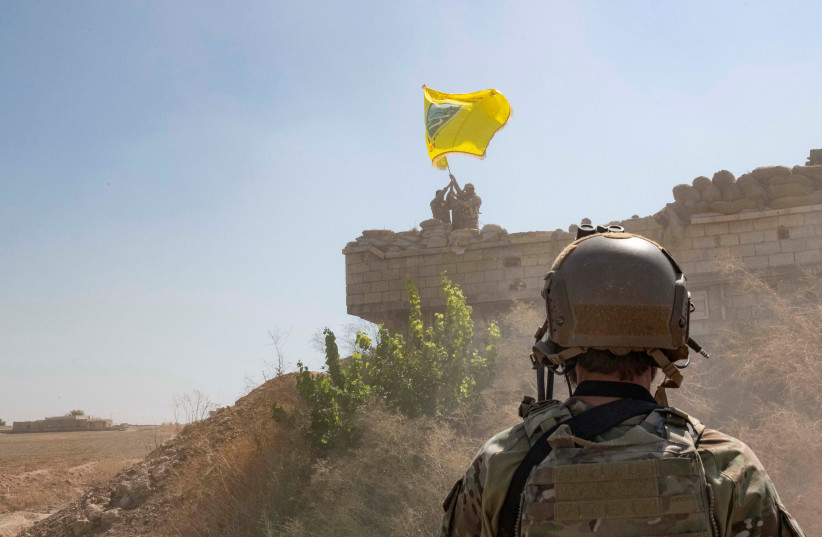Syria's dangerous game: Rocket fire on Israel is major escalation - analysis

Assad's regime enables instability through the kinds of incidents like the rocket fire on Saturday night and Sunday morning.
Rocket fire from Syria is an unprecedented escalation that is unique in its brazenness.
The Syrian regime has been working toward normalization in the region, particularly through outreach to the Persian Gulf and Egypt in recent months. However, the fact that rockets are fired from Syria, on the evening of April 8 and 9, as well as a drone launched from Syria on April 1 targeting Israel, illustrates that the regime is seeking normalization while it doesn’t rein in dangerous terrorist and militant groups.
Israel responded to the rocket fire from Syria on Sunday early in the morning. However, the importance of the rocket fire goes beyond just the rockets themselves or any response.
The Syrian regime was supposed to bring stability and quiet, but it appears that it has allowed terrorist groups to continue to operate openly and threaten others. This is not exactly news, since the regime has tolerated various Iranian-backed groups for years because those groups aided Syria in its civil war.
Syrian regime now playing a dangerous game
What is new is that the regime is now playing a dangerous game by not reining in the groups even as it poses as seeking normalization. Normalization would imply the regime controls its own territory. The regime cannot have it both ways, claiming to control its territory, but allowing attacks on other countries from its territory.
Syria’s regime leader Bashar al-Assad traveled to the UAE on March 19, a symbol of how he has gained new ties in the region. Syria’s foreign minister also went to Egypt on April 1. This was the first trip to Egypt since the outbreak of the Syrian civil war. These are clear examples of Syria seeking normality in the region. With Iran and Saudi also doing reconciliation and talks to end the Yemen war taking place in Oman, clearly, the regime has an opportunity to mend its ways.
On the other hand, Iranian-backed groups in Syria carried out several attacks on US forces in eastern Syria in mid-March, and the US responded with airstrikes on March 23. The rocket fire targeting US troops in eastern Syria now looks similar to how Syria has enabled groups that targeted Israel on April 8-9. These incidents show how the regime continues to tolerate a plethora of armed groups, from Hezbollah to various militias backed by Iran, that undermine the regime’s own narrative of stability.
It's important to recall that the regime is actually reducing its own attempts at stability through these moves. Back in 2018, the Syrian regime was able to retake a swath of the country and return its forces to the Golan. As the regime prepared to return to the Golan, and push aside the Syrian rebels who had operated on the Syrian side since 2012, it put out messages about how it would restore order in the area.
This was important because there were concerns that Syria would bring Hezbollah to the border with Israel and this would create an intolerable threat. In September 2017 reports said that a kind of “buffer zone” on the border could be created, with Russia involved, which would keep threats far from Israel’s border. Russian military police were initially deployed when the regime returned. In August 2018 the Russians were supposed to end up at several points near the border.
Things have changed in southern Syria
However, things have changed over the last several years in southern Syria. There have been increased tensions between former Syrian rebels who reconciled with the regime, and the regime. There has been an increase in the smuggling of drugs by militias near the Jordanian border. Syria continues to also threaten US forces at Tanf garrison in Syria near the Jordanian and Iraqi border. In addition groups like Palestinian Islamic Jihad operate in Damascus. Hezbollah also continues to operate in southern Syria.
The rocket fire overnight on April 8 and 9 is a major escalation in terms of the Syrian front and also the ability of groups to operate from near the Golan and threaten Israel. This brings back memories of some of the chaos during the Syrian Civil War, when there were often threats and concerns about security along the Golan border. However, today the Syrian regime is not in the same spot that it was back in 2015 or 2016. The regime is now seeking to retake more parts of the country. Syria is working with Russia and in talks with Iran and Turkey.
Those talks continue to falter regarding Turkey’s withdrawal from northern Syria. However, the overall trend is clear. The regime wants to portray itself as in charge of the country. At the same time, the regime enables instability through the kinds of incidents like the rocket fire on Saturday night and Sunday morning.
Jerusalem Post Store
`; document.getElementById("linkPremium").innerHTML = cont; var divWithLink = document.getElementById("premium-link"); if (divWithLink !== null && divWithLink !== 'undefined') { divWithLink.style.border = "solid 1px #cb0f3e"; divWithLink.style.textAlign = "center"; divWithLink.style.marginBottom = "15px"; divWithLink.style.marginTop = "15px"; divWithLink.style.width = "100%"; divWithLink.style.backgroundColor = "#122952"; divWithLink.style.color = "#ffffff"; divWithLink.style.lineHeight = "1.5"; } } (function (v, i) { });

